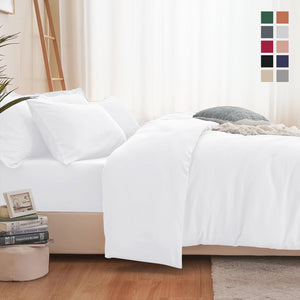Best Bedding Materials for Sensitive Skin
If you have sensitive skin, you already know how easily irritation, itching, or redness can disrupt your comfort — especially while sleeping. What you might not realise is that your bedding could be the culprit.
From the fabrics used to the way they’re treated, your bed sheets, pillowcases, and duvet covers can either soothe your skin or aggravate it. In this UK-focused guide, we’ll explore the best bedding materials for sensitive skin, their benefits, and how to care for them for maximum comfort.
Best Bedding Materials for Sensitive Skin
Here’s a quick comparison to help you choose the right bedding:
| Material | Skin Benefits | Breathability | Hypoallergenic | Best For | UK Availability |
|---|---|---|---|---|---|
| Organic Cotton | Soft, chemical-free, breathable | High | Yes | Year-round comfort | Widely found |
| Bamboo | Naturally hypoallergenic, silky texture, moisture-wicking | Very High | Yes | Hot sleepers, summer use | Moderate |
| Linen | Breathable, antibacterial, moisture-absorbing | High | Yes | Warm weather | Common |
| Silk | Gentle on skin, reduces friction, regulates temperature | Medium | Yes | Acne-prone, eczema skin | Luxury stores |
| Tencel (Lyocell) | Sustainable, soft, moisture-wicking, hypoallergenic | High | Yes | Allergy-prone sleepers | Growing |
1. Organic Cotton Bedding
-
Why it’s great for sensitive skin: Organic cotton is grown without pesticides or harsh chemicals, making it gentle, breathable, and safe for delicate skin.
-
Care tip: Wash at 40°C with fragrance-free detergent to maintain softness.
2. Bamboo Bedding
-
Why it’s great for sensitive skin: Bamboo is naturally hypoallergenic and has a silky texture that glides against the skin. Its moisture-wicking abilities keep skin cool and dry, perfect for UK summers.
-
Care tip: Use a gentle wash cycle and avoid fabric softeners to maintain fibre strength.
3. Linen Bedding
-
Why it’s great for sensitive skin: Linen is breathable and has antibacterial properties. It’s ideal for hot sleepers but can feel slightly textured, so it’s better for mild sensitivity rather than extreme eczema.
-
Care tip: Wash in cool water, avoid tumble drying to preserve fibre quality.
4. Silk Bedding
-
Why it’s great for sensitive skin: Silk pillowcases reduce friction, which helps prevent acne, wrinkles, and irritation. It’s naturally temperature-regulating, keeping you warm in winter and cool in summer.
-
Care tip: Hand wash or use a silk-safe detergent on a delicate cycle.
5. Tencel (Lyocell) Bedding
-
Why it’s great for sensitive skin: Tencel is an eco-friendly fibre made from wood pulp. It’s soft, breathable, moisture-wicking, and hypoallergenic, making it ideal for allergy-prone skin.
-
Care tip: Wash in cold water with mild detergent to protect fibres.

Bedding Care Tips for Sensitive Skin
| Care Step | Why It Matters |
|---|---|
| Use fragrance-free, hypoallergenic detergent | Avoids chemical irritation |
| Wash weekly at 40–60°C | Removes dust mites, bacteria |
| Avoid fabric softeners | Can leave residue that irritates the skin |
| Dry bedding in sunlight | Natural antibacterial benefits |
| Store in a cool, dust-free place | Prevents allergen build-up |
Why Bedding Choice Matters for Sensitive Skin?
Sensitive skin isn’t just about feeling “a bit itchy.” For people prone to eczema, psoriasis, dermatitis, acne, or seasonal allergies, the wrong fabric can cause inflammation, rashes, or breakouts.
Key reasons bedding can trigger irritation:
-
Harsh chemicals are used in fabric dyes or finishing processes.
-
Synthetic fibres that trap heat and sweat.
-
Rough textures that cause friction against the skin.
-
Dust mites thrive in certain fabrics.

Factors to Consider When Choosing Bedding for Sensitive Skin
When shopping in the UK for skin-friendly bedding, look beyond colour and thread count. Focus on these essential factors:
-
Fabric Softness
-
Smooth, gentle fibres minimise friction and prevent micro-tears in the skin barrier.
-
Breathability
-
In the UK’s mild yet humid climate, breathable bedding prevents overheating and reduces sweat-related irritation.
-
Hypoallergenic Properties
-
Bedding that naturally resists dust mites, mould, and bacteria is ideal for allergy-prone sleepers.
-
Moisture-Wicking Abilities
-
Pulling moisture away from the skin reduces bacterial growth and keeps skin fresh.
-
Certifications
-
Look for OEKO-TEX® or GOTS (Global Organic Textile Standard) to ensure the bedding is free from harmful chemicals.
Seasonal Bedding Choices in the UK
-
Summer: Bamboo and linen for breathability.
-
Winter: Organic cotton flannel and silk for warmth.
-
Year-round: Tencel and organic cotton percale for balanced comfort.
Expert Tips for Skin-Friendly Bedding
-
Tip 1: Always check for OEKO-TEX® or GOTS certification.
-
Tip 2: Wash new bedding before first use to remove any finishing chemicals.
-
Tip 3: Choose light, breathable weaves like percale or sateen for comfort in the UK climate.
Final Thoughts
Choosing the best bedding materials for sensitive skin is about balancing softness, breathability, and hypoallergenic properties. Whether you opt for organic cotton, bamboo, silk, linen, or Tencel, investing in the right bedding will protect your skin and improve your sleep quality.
For UK sleepers, the best approach is to choose seasonally, ensure your fabrics are certified chemical-free, and maintain a regular washing routine. Your skin will thank you — and so will your sleep.
FAQs – Best Bedding for Sensitive Skin
1. What bedding is best for eczema-prone skin in the UK?
Organic cotton and bamboo are the best choices because they’re soft, breathable, and chemical-free.
2. Are bamboo sheets better than cotton for sensitive skin?
Bamboo is softer and more moisture-wicking, but high-quality organic cotton is equally good if you prefer a more traditional fabric feel.
3. Which pillowcase is best for acne-prone skin?
Silk pillowcases reduce friction and prevent bacteria build-up, making them great for acne-prone skin.
4. Does thread count matter for sensitive skin?
Yes — but higher isn’t always better. Around 300–400 is ideal for breathability and softness.
5. How often should I change bedding to avoid skin irritation?
Once a week is best, or every 3–4 days for pillowcases.







